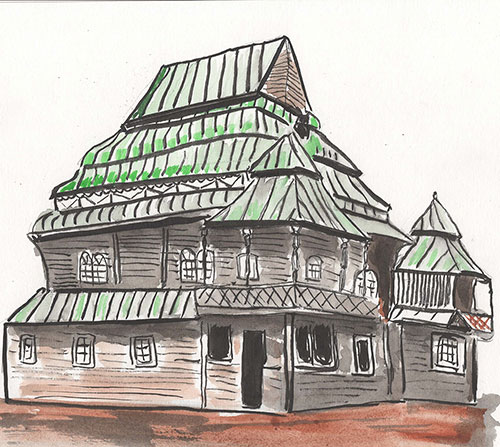Lost Treasures: The Wooden Synagogues of Eastern Europe The Artwork of Bill Farran
Narowlya, Belarus - Sumi-e Style Brush Painting
Narowlya, Belarus - Sumi-e Style Brush Painting
Yiddish: Narovla
Narowlya is located in southern Belarus near the Ukranian border on the Pripyat River. There has been a Jewish presence in the town since the 18th century, but little is known about the early history. As a rule, nobility invited Jews to live and work on their estates. There was a large wooden synagogue built in the middle of the 19th century. In addition, there was a two-story palace, now in ruin, built by the town’s owner, David Horvatt, in 1830. From these two artifacts one can recreate Narowlya’s history. The large synagogue and palace indicate that the relationship between the nobles and the Jews was profitable for both.
In 1793, Narowlya, along with the rest of Belarus, became part of the Russian Empire and fell into the Pale of Settlement. According to the census of 1897, more than 1,000 Jews lived here, and they accounted for 92.5% of the population. After the Russia Revolution the palace became state owned and was badly vandalized. The Soviet Communist government closed the synagogue for worship in 1919. During World War II, as the Nazi army moved into Soviet Russia, many Belorussian Jews attempted to escape but most were unsuccessful. Jews were murdered by both SS troops and by local Belorussian police.
After the disaster at the Chernobyl nuclear power plant in 1986, Narowlya was located in part of the contaminated zone of voluntary resettlement. Today its population is about eight thousand people and there are no Jews.
Purchase a print
Sumi-e Style Brush Prints are 8x10 inches, in an 11x14 matte.
